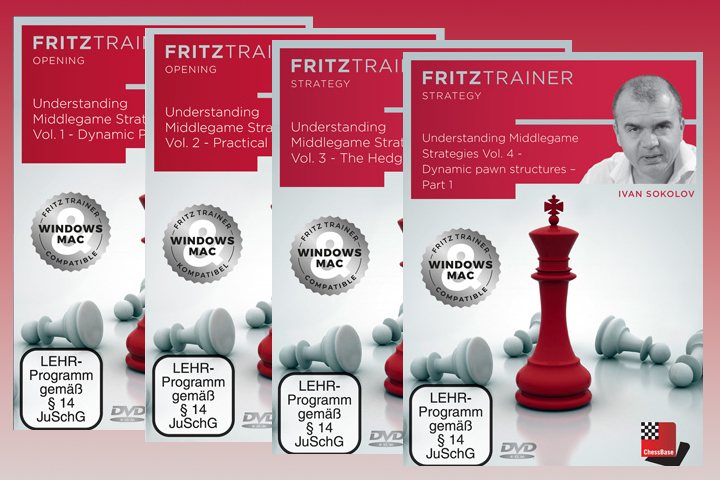


By Harald Wagner
In the sixth part of the DVD series ‘Understanding Middlegame Strategies’, world-class player and trainer GM Ivan Sokolov explores the middlegame treatment of one of the most important structures in chess: the main variations of the closed Spanish.
The expression ‘Ruy Lopez Structures’ in the title is somewhat misleading. Mainly the classics are treated: the traditional Chigorin system in its historic development and the modern Zaitsev and Breyer variations.
Shortly before the pandemic, Ivan Sokolov published a monograph on the Ruy Lopez Main Variation with another Ivan, GM Ivan Salgado Lopez, entitled ‘The Chigorin Bible’, and since it is a bible he hints at what he considers to be the very main line in the Spanish.
In his DVD intro he also refers to his more than 30 years of experience as a tournament player in these positions. However, it was only after the end of his career in 2014 that he really succeeded in recognizing deep systematic connections as a trainer, simply because he had more time to occupy himself with a specific position.
As a tournament player it was always just about the next tournament.
Sokolov also deals extensively with strategic mistakes of world-class players and world champions. He devotes two videos to typical mistakes or misjudgements by Bobby Fischer, but of course mainly to learn from them. In general, this is a topic for him: how can world-class players, including himself, be so wrong with blatant strategic decisions?
One knows one’s own games best, and so the round of dos and don’ts in the closed Spanish begins with two games he lost.
Sokolov with black, against Shirov, moved his pawn to c5 in this key position:
Afterwards, he calls his move a grave mistake. He — consciously — deprives himself of the counterplay on the queenside in the — erroneous — assumption that he can play a kind of King's Indian. However, it is not Black but White who is about to attack on the kingside and the white plan with the pawn on g4, which is otherwise rather questionable, becomes deadly with a completely sealed queenside.
In the second video, Sokolov shows his game against Peter Svidler, this time in the Breyer Variation. In the following position he played g6 himself, which is heavily criticized by him, and Svidler replied with b3, which was highly praised:
Pawn to g6 is criticized because Black fails to initiate queenside counterplay with c4, while Svidler’s b3 is praised because he can now reply to b4 with c4 and to c4 with b4, and the queenside remains closed. Later on Svidler also played g4 and got a strong attack.
If the pawn chains c4-d5-e4 (White) and c5-d6-e5 (Black) arise, Black must be careful so as not to get a ‘lousy old-Indian’ structure.
How effective Black counterplay is realized at the very highest level is shown by Sokolov in a World Championship-themed tournament between the two big Ks:
Years of thematic play in the Zaitsev Variation between Kasparov and Karpov in two World Championship battles shows they really wanted to know what was behind this line.
Black has two different basic plans: to play f5 in order to capture the d5-pawn, and to create piece play on the queenside initiated with pawn to c4.
In the f5-variation the move sequences are very, very concrete and no final judgement is possible. So that the viewer can play the f5-variation with White without a truckload of theory books. Sokolov does show theory though, by presenting Shirov’s newer idea of pawn to g4 as a reaction to pawn f5, after which the game continues along strategic lines.
More dear to Sokolov’s heart than f5 is the more methodically motivated counterplay on the queenside with pawn to c4. In the main line, Black has to sacrifice his b-pawn, but can activate his pieces:
Karpov had just moved rook to b8 and turned a Spanish into a kind of Volga Gambit. The pressure on the b-file and the potential penetration of the knight on d3 combined with the bishop on a6 — whose sphere of influence was only really increased by the disappearance of the b-pawn — clearly gave Karpov the initiative.
Kasparov felt compelled to give back his extra pawn with e5 at once. As a result, Karpov gained a winning position, but was inferior to Kasparov’s tactical abilities in a complicated battle and even lost in the end.
And as a digression: quite incidentally, and this is probably Sokolov’s strongest didactic achievement on this DVD, he shows how to unravel and explain a highly tactical position without getting lost in tactical variations.
In addition, Sokolov also presents a historic game, namely Bogoljubov against Rubinstein, played in Baden-Baden in 1925. Bogo closed off the centre early, locked the queenside and then proceeded with g4 as was usual at the time.
Rubinstein had just moved Nf7 and for the first time used a plan that found its way into the textbooks, which is sometimes linked to his name:
Nevertheless, with the queenside blocked, this is disadvantageous for Black. A few moves later, Bogoljubow correctly made the typical knight sacrifice on f5. After somewhat inaccurate play on both sides, however, the game ended in a draw.
Sokolov shows video that positional misjudgements like a premature g4 can happen even to the greats, like Bobby Fischer. In the 1962 Candidates Tournament Fischer attacked early with g4 against Keres:
And Keres immediately posed problems with h5! Fischer tried to hold the g4 pawn with a knight to h2, but that opened the way for Keres’ g5 bishop and Black already had a slight positional advantage.
And one more little digression, since it contains an important practical tip from Sokolov: the Keres Variation is still relatively popular today. In the main variation, Black captures with the e-pawn on d4, then provokes White to d5 and has a modern Benoni-type position. These lines are very tactical and are characterized by extensive concrete opening theory, sometimes beyond move 30.
Here Sokolov advises White to play d5 directly, as Fischer had done, but of course not g4. White thus avoids concrete theory variations and again relies on a strategic, methodically motivated approach, which is a general tendency in Sokolov.
If he otherwise gives no or hardly any concrete theory recommendations, it is significant insofar as the Keres Variation is also regularly played by world-class players like Caruana.
Sokolov then also brings the clearest explanations to this. The most obvious advantage of f4 for White is that he can use the half-open f-file for his kingside attack, and besides that, the square d4 becomes free for a white knight if there is no black pawn on c5.
The most obvious disadvantage of f4 is that the white pawn on e4 becomes a backward pawn and the square e5 becomes a strong outpost for the black pieces.
Sokolov distinguishes two cases here. If the square e5 is not at all easily accessible for the black pieces, it is simple: White is better off. But what if Black can occupy e5 directly, preferably with a knight? If we follow Sokolov, many players have to rethink their strategies, and here is an example from a game between Zherebukh and Caruana:
If I had been shown this position and then also mentioned that Caruana had just moved knight to e5, I would have replied, “Sure, Caruana is winning”.
But Sokolov notes that although Black can block on e5, the white attack potential against the black king is to be worth taking into consideration. The strategic weaknesses of the white position only come into play with the exchange of queens and/or in the endgame. Checkmate simply wins the game.
Less of a concrete variation and more of a transition into a Sicilian pawn structure is the double exchange on d4, which Black can bring about in many positions. Therefore, knowledge of this plan is also essential for the Closed Spanish. Sokolov gives a Spassky vs Keres game as one of several examples:
Keres subsequently exchanged twice on d4 and a typical Sicilian position emerged, with a slightly weak pawn on d6, but pressure against e4, which has been seen in countless games.
Sokolov notes that ‘space matters’.
Here Spassky moved his knight to d4 and f5, which is excellent, and he won in style.
However, Sokolov refers to an even better move he found with the help of Stockfish. With Nd5! White already has a winning position, since the a5-knight never gets into the game: ...Nc6 doesn’t work because of the exchange on c6 and the capture on f6, and if Black exchanges on d5 and tries to play the knight to b5, White simply moves b4!!, and the shop remains closed for the black knight. On d8 he won’t be happy either because the white pawn on d5 then controls the squares c6 and e6.
You can safely imagine the white skeleton of a black knight in some desert.
To be clear, what is not discussed here is no worse than what we present. The sheer number and running time of the videos would make a more comprehensive individual review far beyond the scope of this article. The less common pawn structures of the Closed Spanish and also some of the Open Spanish are also discussed.
Leaving other games by Fischer, Kasparov and Carlsen out of the review was not easy.
The Ruy Lopez is really not as complex as it is sometimes rumoured to be. After watching Sokolov’s DVD, you can understand everything really well, almost effortlessly.
And if I may add my opinion, one that I had shared when reviewing Sokolov’s Sicilian DVD:
And one last thing: in practice, Black usually plays short castling with a pawn on d6 to feign a possible Marshall attack. If White then dutifully chooses one of the many anti-Marshall lines, the content of this DVD is really ‘pure art’, which manifests itself mainly in deepening one’s own understanding of the position.
It is perhaps interesting to see what Sokolov’s pupil Abdusattorov has contributed to the exploration of the Rossolimo, the Maroczy and the Ruy Lopez. He has come up with a number of new and original variations in the Maroczy and also in the Ruy Lopez.
In the Chigorin, he even plays a move that Sokolov writes about in his ‘Chigorin Bible’, explaining why he did not include it there, and it is not on this DVD either. So there is still a lot of room for research.
And another tip: you can always learn from Carlsen’ games, so why not take a look at his losing games in the Chigorin? But that’s already a very concrete instruction for building up a Black repertoire — you’d actually have to charge money for it.
Not really, but for the 16 videos on the DVD with a running time of more than seven hours, you need lots of resilience or, as they used to say, a lot of sitting, while studying the lines of the ‘Spanish torture’. Nevertheless, we Soko-Lov(e)d the DVD and are lookign forward to more instructive videos in the future.

Uzbekistan won the Chennai Olympiad with Ivan Sokolov as their coach | Photo: FIDE
The volumes are all available individually and in various bundles.
| Advertising |